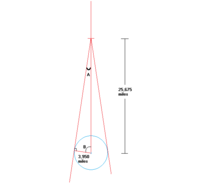brokenwatch
New member
- Joined
- Jul 18, 2019
- Messages
- 7
The problem:
A satellite in synchronous orbit with the earth (it always stays above a fixed point on the earth's surface)
has a radius of orbit 6.5 times the earth's radius (3950 miles).
The satellite relays a signal from one point on earth to another on earth (so, in a distance that's an arc).
The sender & receiver signal must be within a line of sight w/the satellite.
What's the maximum (arc) distance on the surface of the earth between the sender & receiver for this satellite? Round to the nearest mile.
My work:
The earth's radius is r=3950, and the distance of the orbit radius extended all the way to the center of the earth is R=3950+(6.5*3950)=29625.
The satellite's lines of sight over the earth are tangent to it, so touch at 90 degree angles with two radii from Earth's center to those points.
Two right triangles are formed by the lines of sight, the two radii, and the distance from the satellite to the earth's center, where R=29625 is the hypotenuse of both triangles.
So, to find the arc distance between the two points (where the lines of sight touch Earth) I used:
s = 3950(2cos^-1(3950/29625)), which is approx. 11,353 miles.
Now, the problem is, the answer is approximately 11,189 miles. How am about 164 miles off?
A satellite in synchronous orbit with the earth (it always stays above a fixed point on the earth's surface)
has a radius of orbit 6.5 times the earth's radius (3950 miles).
The satellite relays a signal from one point on earth to another on earth (so, in a distance that's an arc).
The sender & receiver signal must be within a line of sight w/the satellite.
What's the maximum (arc) distance on the surface of the earth between the sender & receiver for this satellite? Round to the nearest mile.
My work:
The earth's radius is r=3950, and the distance of the orbit radius extended all the way to the center of the earth is R=3950+(6.5*3950)=29625.
The satellite's lines of sight over the earth are tangent to it, so touch at 90 degree angles with two radii from Earth's center to those points.
Two right triangles are formed by the lines of sight, the two radii, and the distance from the satellite to the earth's center, where R=29625 is the hypotenuse of both triangles.
So, to find the arc distance between the two points (where the lines of sight touch Earth) I used:
s = 3950(2cos^-1(3950/29625)), which is approx. 11,353 miles.
Now, the problem is, the answer is approximately 11,189 miles. How am about 164 miles off?

